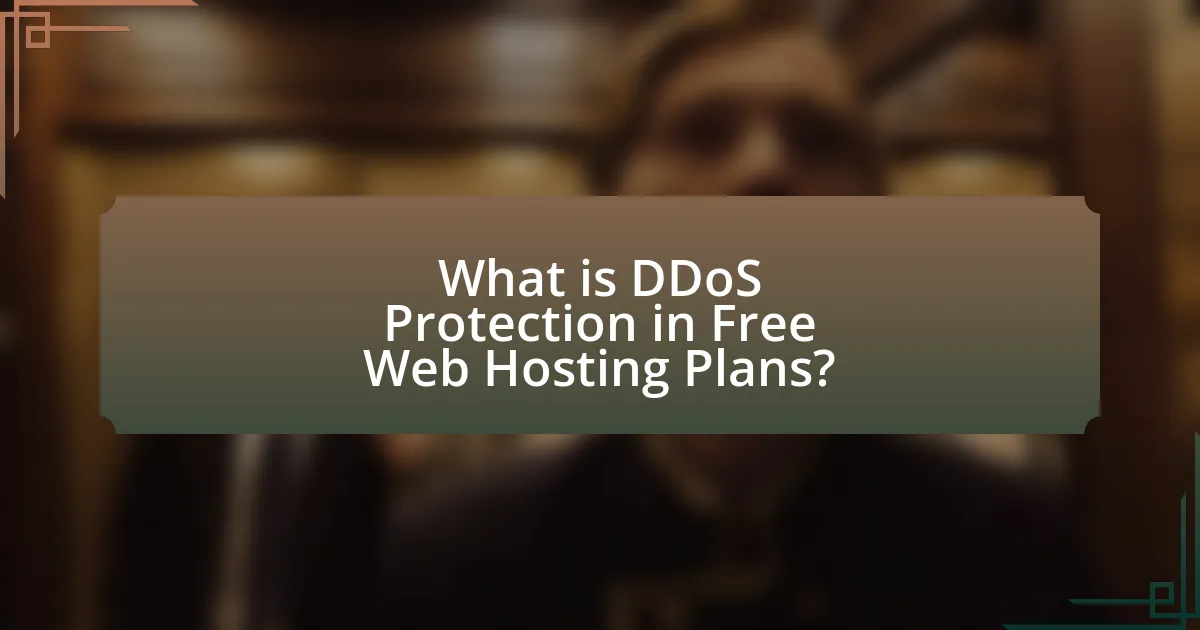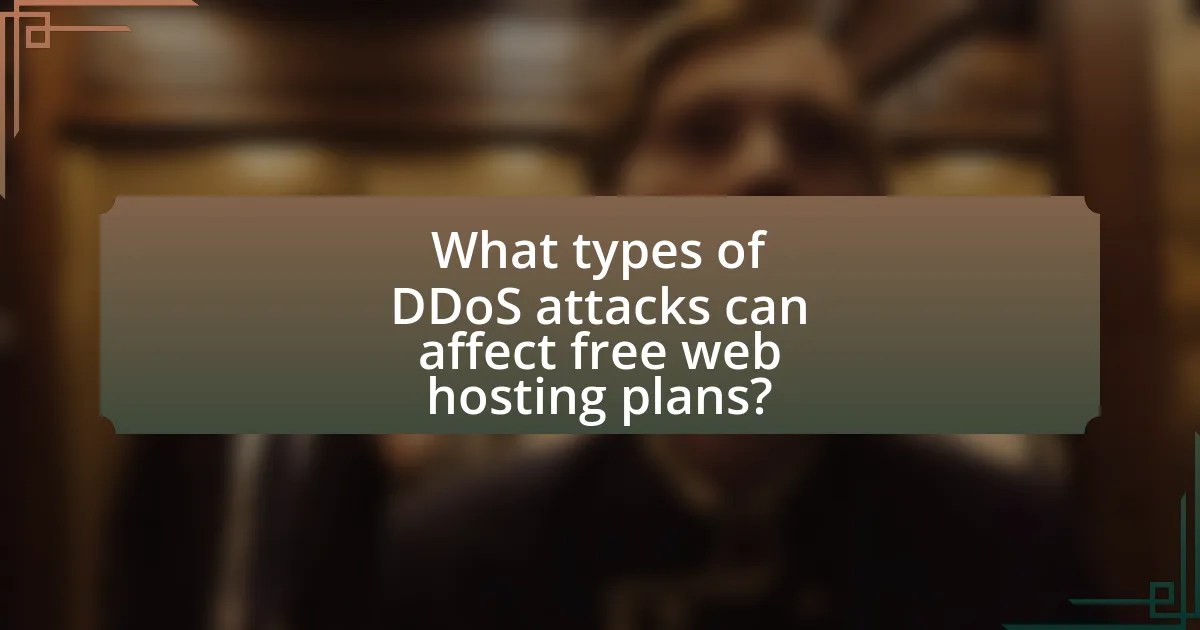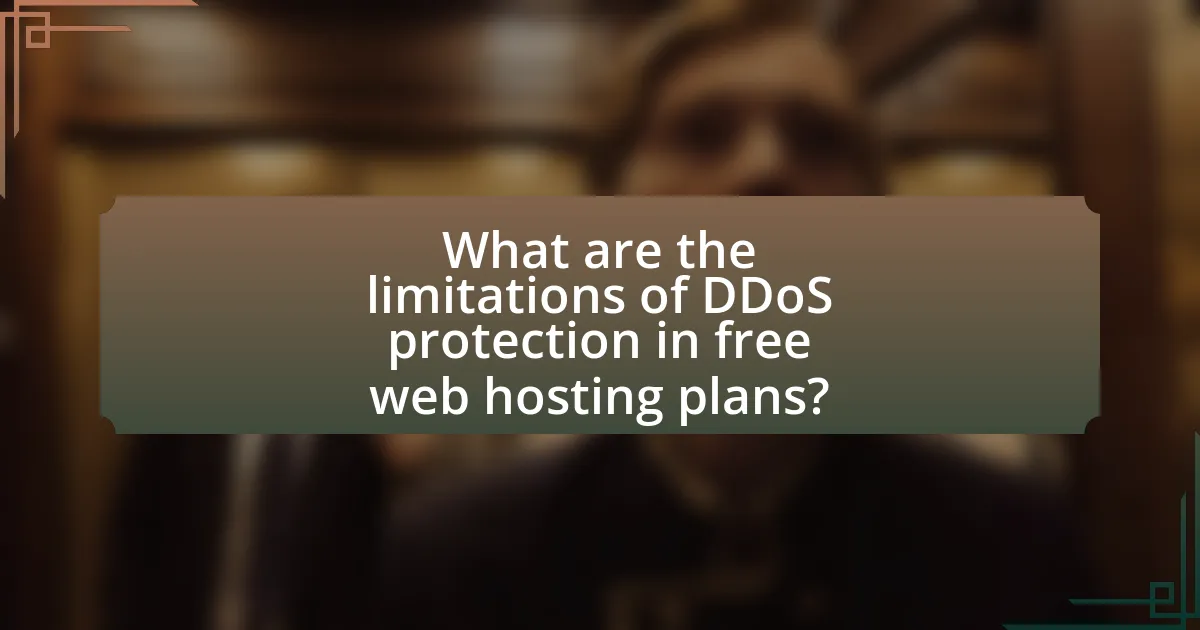DDoS protection in free web hosting plans encompasses various measures designed to defend websites against Distributed Denial of Service attacks, which can incapacitate servers by overwhelming them with traffic. This article examines how DDoS protection functions within free hosting environments, detailing key components such as traffic analysis, rate limiting, and threat intelligence. It highlights the importance of DDoS protection for users of free web hosting services, the risks associated with inadequate protection, and the types of DDoS attacks that can affect these plans. Additionally, the article discusses the limitations faced by free hosting providers in implementing effective DDoS protection and offers practical steps users can take to enhance their security against such threats.

What is DDoS Protection in Free Web Hosting Plans?
DDoS protection in free web hosting plans refers to measures implemented to safeguard websites from Distributed Denial of Service attacks, which aim to overwhelm a server with traffic, rendering it inaccessible. Many free web hosting providers include basic DDoS protection features to mitigate the risk of such attacks, ensuring that their users’ websites remain operational even under potential threat. For instance, these protections may involve traffic filtering, rate limiting, and the use of content delivery networks (CDNs) to distribute traffic loads. The effectiveness of DDoS protection can vary significantly among providers, with some offering more robust solutions than others, which is crucial for maintaining uptime and reliability for users relying on free hosting services.
How does DDoS protection work in free web hosting environments?
DDoS protection in free web hosting environments typically involves the use of basic traffic filtering and rate limiting to mitigate attacks. Free web hosting providers often implement measures such as IP blacklisting, where known malicious IP addresses are blocked, and traffic analysis to identify unusual patterns that may indicate a DDoS attack. These providers may also utilize shared resources to absorb excess traffic, although the effectiveness can be limited compared to paid services. According to a report by Cloudflare, free hosting services often lack advanced DDoS mitigation technologies, making them more vulnerable to sustained attacks.
What are the key components of DDoS protection systems?
The key components of DDoS protection systems include traffic analysis, rate limiting, and threat intelligence. Traffic analysis enables the detection of abnormal patterns that indicate a DDoS attack, allowing for timely responses. Rate limiting controls the amount of traffic sent to a server, preventing overload during an attack. Threat intelligence provides insights into known attack vectors and malicious IP addresses, enhancing the system’s ability to filter out harmful traffic. These components work together to mitigate the impact of DDoS attacks effectively.
How do these components interact to mitigate DDoS attacks?
Components such as firewalls, load balancers, and intrusion detection systems interact to mitigate DDoS attacks by filtering malicious traffic, distributing legitimate requests, and identifying attack patterns. Firewalls block unwanted traffic based on predefined rules, while load balancers ensure that incoming requests are evenly distributed across multiple servers, preventing any single server from becoming overwhelmed. Intrusion detection systems monitor network traffic for suspicious activity, allowing for real-time responses to potential threats. Together, these components create a layered defense that enhances the overall resilience of web hosting services against DDoS attacks, as evidenced by the effectiveness of multi-layered security strategies in reducing downtime and maintaining service availability during attacks.
Why is DDoS protection important for free web hosting users?
DDoS protection is crucial for free web hosting users because it safeguards their websites from overwhelming traffic attacks that can lead to downtime and loss of service. Free web hosting services often lack robust security measures, making them attractive targets for attackers seeking to disrupt services. Without DDoS protection, a website can become inaccessible during an attack, resulting in potential revenue loss, damage to reputation, and a decrease in user trust. According to a report by the Cybersecurity & Infrastructure Security Agency, 70% of organizations that experience a DDoS attack report significant operational disruptions. Thus, implementing DDoS protection is essential for maintaining website availability and ensuring a reliable user experience for free web hosting users.
What risks do free web hosting plans face without DDoS protection?
Free web hosting plans without DDoS protection face significant risks, primarily including service downtime and data loss. Without DDoS protection, these hosting services are vulnerable to Distributed Denial of Service attacks, which can overwhelm servers with traffic, rendering websites inaccessible. This can lead to a loss of user trust and potential revenue, as studies indicate that 40% of users abandon a website that takes more than three seconds to load. Additionally, the lack of DDoS protection can expose sensitive data to malicious actors, increasing the risk of data breaches. Consequently, free web hosting plans without adequate DDoS safeguards are at a heightened risk of operational disruptions and security vulnerabilities.
How can DDoS attacks impact website performance and availability?
DDoS attacks can severely degrade website performance and availability by overwhelming the server with excessive traffic, rendering it unable to respond to legitimate user requests. This influx of malicious traffic can lead to slow loading times, timeouts, and ultimately, complete service outages. For instance, a study by the cybersecurity firm Akamai reported that DDoS attacks can increase response times by up to 50% and cause downtime that can last from minutes to days, depending on the attack’s scale and duration. Consequently, websites targeted by DDoS attacks often experience significant disruptions, negatively affecting user experience and potentially leading to loss of revenue and reputation.

What types of DDoS attacks can affect free web hosting plans?
Free web hosting plans can be affected by several types of DDoS attacks, including volumetric attacks, protocol attacks, and application layer attacks. Volumetric attacks, such as UDP floods and ICMP floods, overwhelm the bandwidth of the hosting service, making it inaccessible. Protocol attacks, like SYN floods, exploit weaknesses in the network protocols to exhaust server resources. Application layer attacks, such as HTTP floods, target specific applications or services, consuming server resources and leading to downtime. These attacks are particularly concerning for free web hosting plans, which often lack robust security measures and resources to mitigate such threats effectively.
What are the most common types of DDoS attacks?
The most common types of DDoS attacks include volumetric attacks, protocol attacks, and application layer attacks. Volumetric attacks, such as UDP floods and ICMP floods, aim to overwhelm the bandwidth of the target by generating massive amounts of traffic. Protocol attacks, like SYN floods, exploit weaknesses in network protocols to exhaust server resources. Application layer attacks, such as HTTP floods, target specific applications to disrupt service by overwhelming them with requests. According to the 2022 DDoS Threat Landscape report by NETSCOUT, volumetric attacks accounted for 80% of all DDoS attacks, highlighting their prevalence and impact.
How do volumetric attacks differ from protocol attacks?
Volumetric attacks differ from protocol attacks primarily in their method of overwhelming a target. Volumetric attacks aim to saturate the bandwidth of a target by generating a high volume of traffic, often measured in bits per second, which can lead to service disruption. In contrast, protocol attacks exploit weaknesses in the protocols used by network devices, targeting specific aspects of the communication process to exhaust resources, such as CPU or memory, rather than bandwidth. For example, a volumetric attack might involve a Distributed Denial of Service (DDoS) attack that floods a server with traffic, while a protocol attack could involve sending malformed packets to a server to exploit vulnerabilities in the Transmission Control Protocol (TCP). This distinction is crucial for understanding the different strategies required for effective DDoS protection in free web hosting plans.
What are application layer attacks and their implications?
Application layer attacks are a type of cyberattack that target the application layer of the OSI model, specifically aiming to disrupt the functionality of web applications by overwhelming them with malicious requests. These attacks can lead to significant implications, including service downtime, loss of revenue, and damage to a company’s reputation, as they exploit vulnerabilities in the application code or the underlying infrastructure. For instance, according to a report by Akamai, application layer attacks accounted for 50% of all DDoS attacks in 2020, highlighting their prevalence and potential impact on businesses relying on web services.
How can free web hosting providers implement DDoS protection?
Free web hosting providers can implement DDoS protection by utilizing traffic filtering and rate limiting techniques. Traffic filtering involves analyzing incoming data packets to identify and block malicious traffic patterns associated with DDoS attacks, while rate limiting restricts the number of requests a user can make to the server within a specific timeframe, thereby mitigating the impact of excessive requests. Additionally, employing a Content Delivery Network (CDN) can distribute traffic across multiple servers, reducing the load on any single server and enhancing resilience against DDoS attacks. These methods are supported by industry practices, as many providers leverage similar strategies to safeguard their infrastructure against such threats.
What technologies are used for DDoS mitigation?
DDoS mitigation technologies include traffic filtering, rate limiting, and scrubbing services. Traffic filtering identifies and blocks malicious traffic based on predefined rules, while rate limiting controls the amount of traffic sent to a server, preventing overload. Scrubbing services redirect traffic through a cleaning center that removes harmful packets before they reach the target server. These technologies are essential for maintaining service availability during DDoS attacks, as evidenced by their widespread adoption in cybersecurity strategies across various industries.
How effective are these technologies in a free hosting context?
DDoS protection technologies are generally less effective in a free hosting context due to limited resources and support. Free hosting services often lack robust infrastructure and dedicated security measures, making them more vulnerable to DDoS attacks. For instance, a study by the Ponemon Institute found that 60% of organizations using free or low-cost hosting experienced significant downtime due to DDoS attacks, highlighting the inadequacy of such protections in these environments. Additionally, free hosting providers may prioritize cost-cutting over security, further diminishing the effectiveness of any DDoS mitigation technologies they offer.

What are the limitations of DDoS protection in free web hosting plans?
DDoS protection in free web hosting plans is often limited in effectiveness and scope. These plans typically lack advanced security features, such as traffic filtering and rate limiting, which are essential for mitigating large-scale attacks. Additionally, free hosting services may not have the infrastructure or resources to handle significant traffic surges caused by DDoS attacks, leading to potential downtime or service interruptions. Furthermore, the support for DDoS protection in free plans is usually minimal, with little to no customer service assistance available during an attack. This combination of inadequate resources and support makes free web hosting plans vulnerable to DDoS threats, resulting in a higher risk of service disruption.
What challenges do free web hosting providers face in offering DDoS protection?
Free web hosting providers face significant challenges in offering DDoS protection primarily due to limited resources and infrastructure. These providers often operate on tight budgets, which restricts their ability to invest in advanced security technologies and dedicated bandwidth necessary to mitigate DDoS attacks effectively. Additionally, the high volume of users on free hosting platforms can lead to resource contention, making it difficult to allocate sufficient protection for individual sites. According to a report by Cloudflare, 70% of DDoS attacks target small to medium-sized businesses, highlighting the vulnerability of free hosting services that lack robust security measures.
How does resource allocation affect DDoS protection capabilities?
Resource allocation significantly impacts DDoS protection capabilities by determining the amount of bandwidth, processing power, and security resources available to mitigate attacks. When resources are limited, as often seen in free web hosting plans, the ability to absorb and respond to high-volume DDoS attacks diminishes, leading to potential service disruptions. For instance, a study by the Ponemon Institute found that organizations with inadequate resource allocation during a DDoS attack experienced an average downtime of 6 hours, resulting in substantial financial losses. Thus, effective resource allocation is crucial for maintaining robust DDoS protection and ensuring service continuity.
What compromises might users face with free plans regarding security?
Users of free web hosting plans may face significant compromises regarding security, particularly in the area of DDoS protection. Free plans often lack robust security measures, leaving websites vulnerable to Distributed Denial of Service attacks, which can overwhelm servers and disrupt service. According to a report by the Cybersecurity and Infrastructure Security Agency, many free hosting providers do not implement advanced security protocols, such as traffic filtering or rate limiting, which are essential for mitigating DDoS threats. This lack of protection can lead to increased downtime and potential data breaches, as free services typically prioritize cost savings over comprehensive security features.
How can users enhance their DDoS protection on free web hosting plans?
Users can enhance their DDoS protection on free web hosting plans by implementing a combination of security measures such as using a Content Delivery Network (CDN), enabling Web Application Firewalls (WAF), and regularly updating software. A CDN distributes traffic across multiple servers, which can absorb and mitigate DDoS attacks, while a WAF filters malicious traffic before it reaches the server. Additionally, keeping software up to date reduces vulnerabilities that attackers could exploit. These strategies are effective as they leverage existing technologies to bolster security without requiring significant financial investment, which is crucial for users on free hosting plans.
What best practices should users follow to minimize DDoS risks?
To minimize DDoS risks, users should implement a multi-layered security approach that includes using a content delivery network (CDN), enabling rate limiting, and employing web application firewalls (WAF). A CDN distributes traffic across multiple servers, reducing the impact of a DDoS attack by absorbing excess traffic. Rate limiting controls the number of requests a user can make in a given timeframe, preventing overwhelming traffic spikes. A WAF filters and monitors HTTP traffic between a web application and the Internet, blocking malicious requests. These practices are supported by industry standards, such as the Cloudflare DDoS Protection report, which highlights the effectiveness of these strategies in mitigating DDoS threats.
How can users monitor their website for potential DDoS threats?
Users can monitor their website for potential DDoS threats by implementing real-time traffic analysis tools and utilizing web application firewalls (WAFs). Real-time traffic analysis tools, such as Google Analytics or specialized DDoS detection services, allow users to observe unusual spikes in traffic patterns that may indicate an ongoing attack. Web application firewalls can filter and monitor HTTP requests, blocking malicious traffic before it reaches the server. According to a report by the Cybersecurity and Infrastructure Security Agency (CISA), proactive monitoring and the use of these tools can significantly reduce the risk of successful DDoS attacks, as they provide immediate alerts and mitigation strategies.
What are the future trends in DDoS protection for free web hosting?
Future trends in DDoS protection for free web hosting include the integration of AI-driven mitigation strategies, enhanced traffic analysis tools, and the adoption of decentralized protection networks. AI-driven solutions can analyze traffic patterns in real-time, allowing for quicker identification and response to potential threats, which is crucial for free hosting services that may lack extensive resources. Enhanced traffic analysis tools will provide better visibility into attack vectors, enabling more effective filtering of malicious traffic. Additionally, decentralized protection networks, leveraging blockchain technology, can distribute the load and provide a more resilient defense against DDoS attacks, making it feasible for free web hosting providers to offer robust security without significant financial investment. These trends reflect the growing need for scalable and efficient DDoS protection solutions in the competitive landscape of free web hosting.
How is technology evolving to better protect against DDoS attacks?
Technology is evolving to better protect against DDoS attacks through advancements in machine learning, real-time traffic analysis, and enhanced network infrastructure. Machine learning algorithms are increasingly used to identify and mitigate unusual traffic patterns indicative of DDoS attacks, allowing for quicker response times. Real-time traffic analysis tools enable organizations to monitor incoming data flows continuously, facilitating immediate action against potential threats. Additionally, the deployment of more robust network infrastructure, such as content delivery networks (CDNs) and distributed denial-of-service mitigation services, helps absorb and redirect malicious traffic, thereby minimizing the impact of attacks. These developments are supported by industry reports indicating that organizations employing such technologies have seen a significant reduction in downtime and service disruption during DDoS incidents.
What role will AI and machine learning play in DDoS mitigation?
AI and machine learning will play a crucial role in DDoS mitigation by enabling real-time detection and response to attacks. These technologies analyze traffic patterns and identify anomalies that indicate potential DDoS activity, allowing for swift action to mitigate threats. For instance, a study by the University of California, Berkeley, demonstrated that machine learning algorithms could reduce false positives in attack detection by up to 90%, significantly improving the efficiency of DDoS defenses. By leveraging AI, organizations can enhance their ability to predict and respond to evolving DDoS tactics, thereby strengthening their overall security posture.
What practical steps can users take to ensure better DDoS protection?
To ensure better DDoS protection, users should implement a multi-layered security approach that includes using a reputable DDoS mitigation service, configuring firewalls to filter traffic, and regularly updating software and systems. DDoS mitigation services, such as Cloudflare or Akamai, can absorb and deflect malicious traffic before it reaches the server, effectively reducing the impact of an attack. Configuring firewalls to block suspicious IP addresses and limiting the rate of incoming requests can further enhance security. Additionally, keeping software and systems updated helps protect against vulnerabilities that attackers may exploit. These steps are supported by industry best practices, which emphasize proactive measures in safeguarding against DDoS threats.
